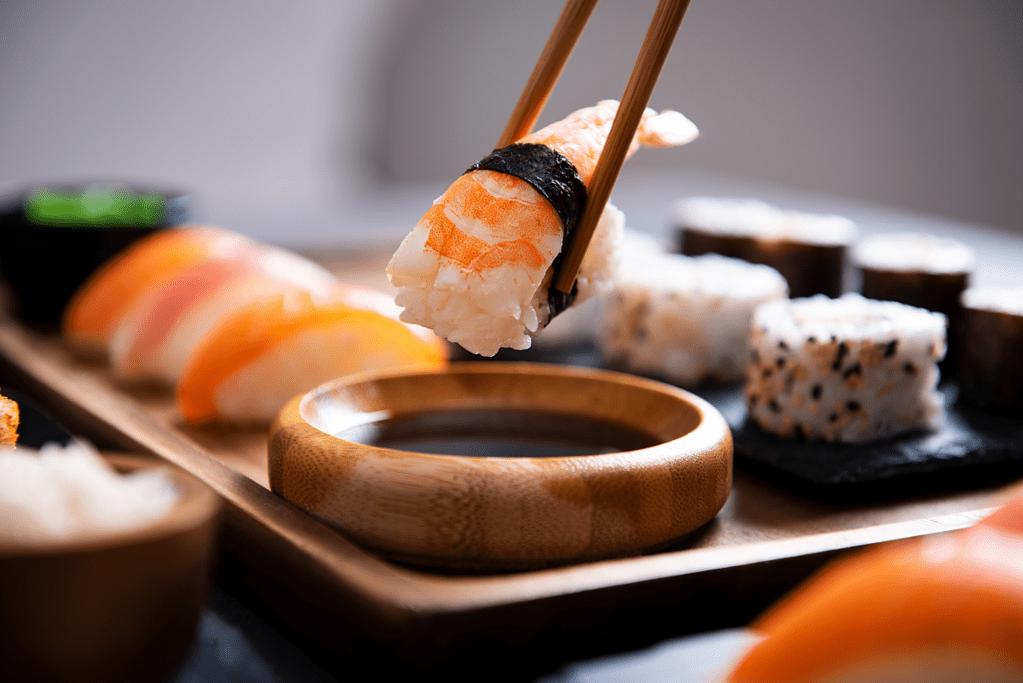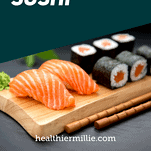If you’re looking for a delicious and healthy way to boost your immune system, look no further than sushi! Sushi is packed with antioxidants, vitamins, and minerals that are essential for optimal health. And there are still more amazing benefits of eating sushi that you’ll soon read about.
Today, this popular Japanese cuisine is enjoyed by people all over the world and is considered to be a healthy and delicious option for a meal or snack. Why have junk food when sushi is readily available?
Sushi has become increasingly popular in recent years. It can be made with a variety of different ingredients, so there is something for everyone to enjoy.
Most people probably think of raw fish when they think about sushi, but sushi actually refers to vinegared rice. However, raw fish is just one type of sushi, and it’s not even the most common type!

The Benefits of Eating Sushi
Sushi is delicious, but it also has a number of benefits that make it a great choice for a healthy meal. Here are just a few of the benefits of eating sushi:
1. Excellent Source of Omega-3 Fatty Acids
Sushi is a great source of omega-3 fatty acids. Sushi is typically made with fatty fish that is high in omega-3 fatty acids. Salmon, tuna, and king mackerel are all great options. You can also get your omega-3 fatty acids from seaweed or fish roe that are on some types of sushi.
These healthy fats have been shown to improve heart health, and high blood pressure, prevent strokes, lower cholesterol levels, reduce inflammation, and prevent chronic diseases. They are also beneficial for cognitive function and hair growth.
Many people don’t get enough omega3 fish oils in their diet, but sushi is a great way to increase your intake and enjoy one of the benefits of eating sushi.
2. High in Protein
Sushi is also an excellent source of protein, and more specifically lean protein, which is essential for muscle repair and growth. A single sushi roll can contain up to 20 grams of protein.
Sushi is a great way to sneak some protein into your diet while still enjoying all of the delicious flavors and textures that make this Japanese food so popular.
3. Packed with Vitamins and Nutrients
Sushi is a great source of Vitamin A which is important for vision, skin health, and immunity. You can also get Vitamin D which is essential for bone health and calcium absorption. Vitamin C is also found in sushi and it is necessary for wound healing and collagen production.
You’ll also get Vitamin B12 from sushi made with nori (seaweed). Sushi is also a good source of the mineral selenium, which has antioxidant properties and may help protect against cancer.
Furthermore, sushi is also packed with other nutrients and minerals like iron for growth and development and calcium for healthy bones and teeth.
4. Great Source of Antioxidants
Sushi is a great way to get your daily dose of antioxidants. In fact, sushi has more antioxidants than most other types of food. The antioxidants in sushi can help to prevent cell damage caused by free radicals and reduce inflammation.
This can lead to a number of health benefits, such as reducing your risk of heart disease and cancer. Antioxidants can also help reduced age-related macular degeneration of your eyes.
5. Helps With Weight Loss and Weight Management
One of the health benefits of eating sushi is that it is relatively low in calories and fat and can help you lose weight, avoid weight gain, or maintain a healthy weight.
A typical sushi roll contains around 200-250 calories, making it a great option for those watching their weight. And because sushi is a good source of protein, it can help you feel full and satisfied after eating.
Sushi rice is usually made with white rice. However, white rice is a refined grain, and it doesn’t have the same health benefits as brown rice. If you’re looking for a healthy sushi option, I recommend choosing sushi that is made with brown rice.
Brown rice is a whole grain, does not cause a spike in your blood sugar levels and it’s a good source of fiber. Fiber can help you stay full and satisfied after eating, and it can also help you reach your weight loss goals.
When you’re choosing sushi at a restaurant, avoid sushi that is deep-fried. Deep-fried sushi is high in calories and fat, and it’s not a healthy option. Also, avoid high-fat sauces like spicy mayo and cream cheese.
6. Great Source of Probiotics
If you’re a fan of sushi, you may be interested to know that it’s a great source of probiotics. Probiotics are live microorganisms that are similar to the beneficial bacteria found in our gut.
Probiotics have many health benefits, including improving digestion, boosting the immune system, reducing inflammation, and preventing diarrhea.
To make sure your sushi has probiotics, look for the following:
- Nori sheets that are marked “live” or “active.”
- Sushi made with brown rice, which has more fiber than white rice and is less likely to be contaminated with harmful bacteria.
- Sushi made with fish that have been wild-caught, as opposed to farm-raised. Wild-caught fish are less likely to be exposed to antibiotics and other chemicals.
Eating probiotic-rich foods like sushi is a great way to improve your gut health. If you’re looking for delicious and healthy food to get your probiotics, sushi is a great option.
7. Versatile Food
In addition to being a healthy dish, sushi is also incredibly versatile. It can be made with a variety of different ingredients. For example, sushi can be made with fresh fish, seafood, vegetables, and even fruit. This means that there are endless possibilities when it comes to creating new and exciting sushi dishes.
Also, sushi can be served in a variety of different ways. For instance, sushi can be served as an appetizer, main course, or even dessert. This means that you can enjoy sushi no matter what time of day it is.
This makes it a great option for those with dietary restrictions or simply looking for a new and exciting way to eat healthily.
8. Helps With Dexterity and Coordination
Believe it or not, since eating sushi requires you to use chopsticks, it can help to improve your dexterity and coordination.
Sushi is often viewed as a delicate dish, and for good reason. Eating sushi requires a certain level of dexterity and coordination.
You have to use your chopsticks to pick up the sushi, dip it in soy sauce, and then eat it without making a mess.
This can be quite tricky if you’re not used to using chopsticks. However, the more you eat sushi the easier it becomes and you’ll be enjoying another benefit of eating sushi.
9. Can Be Meditative
What I didn’t know until recently is that sushi can also be meditative. When most people think of meditation, they imagine someone sitting in the lotus position, with their eyes closed and their mind cleared of all thoughts.
This is one type of meditation, but it’s not the only one. In fact, there are many different ways to meditate, and one of them is by eating sushi!
One reason sushi can be meditative is that it is very simple food. There are no complex flavors or textures to distract you from the experience of eating.
This simplicity allows you to focus on the taste, smell, and feel of the sushi, which can be a very calming and soothing experience helping you to relax and de-stress. When you are focused on the act of eating, you are able to clear your mind and be in the moment.
The repetitive nature of eating sushi can also be soothing. Each bite is an opportunity to focus on the flavors and textures of the fish and rice. If you can find a place to eat where the sushi is fresh and the surroundings are calm, you may be able to achieve a state of mindfulness.

The Healthiest Sushi
The healthiest sushi includes nigiri sushi, temaki sushi, uramaki sushi, maki sushi, and naruto sushi.
Nigiri Sushi
Nigiri sushi is a type of sushi that consists of an oblong mound of rice, topped with a slice of fish or other seafood. The word “nigiri” means “to grasp,” and refers to the way the sushi is made – by hand, using fingers.
Nigiri sushi is traditionally made with white rice, but brown rice or vinegared rice can also be used.
Temaki Sushi
Temaki sushi, which is also known as hand-rolled sushi, is a type of sushi where the rice and fish are rolled inside nori seaweed. Unlike traditional sushi rolls, temaki sushi is cone-shaped and can be eaten with your hands.
There are many different ways to make Temaki sushi, but the most common way is to use salmon, tuna, cucumber, and avocado. Other popular ingredients include crab meat, eel, and shrimp. Temaki sushi can be made with either white or brown rice.
Maki Sushi
Maki sushi is a popular type of sushi in the United States and is made from rice and seaweed. The word “maki” means “rolled.” Maki sushi is usually rolled up in a sheet of nori seaweed and contains various ingredients such as fish, vegetables, and fruit.
Uramaki Sushi
Uramaki sushi is made with rice and seaweed. But unlike other types of sushi, uramaki is rolled with the ingredients on the outside rather than inside. This gives it a different flavor and texture.
This style of sushi originated in California and has since become very popular throughout North American sushi restaurants. There are many different types of uramaki rolls, and they can be filled with anything from vegetables to seafood.
This type of sushi is often confused with maki sushi, which is also known as a “roll” sushi. Maki sushi is wrapped in seaweed, but the rice and filling are on the inside. Uramaki sushi is considered to be more difficult to make than maki sushi, so it tends to be a little bit more expensive.
Naruto
Your favorite Japanese restaurant may make naruto sushi, which is fish or vegetables wrapped in cucumber. This is the healthiest option, especially for those who want to limit their rice or carb intake.

Healthiest Sushi Options
Some of the healthiest sushi ingredients include tuna, salmon, yellowtail, and snapper. These fish are all high in protein and omega-three fatty acids, which are good for your heart.
If you’re looking for a vegetarian option, cucumber rolls are a good choice. Cucumbers are low in calories and high in water content, so they’ll help you stay hydrated.
Avocado sushi is a good choice for those who are looking for a filling and satisfying plant-based meal.
One Concern of Eating Sushi
You may have heard of the concern many people have with the mercury levels found in seafood. Similarly, there is a also a concern with mercury levels found in sushi.
A recent study found high mercury levels in a number of popular sushi items. Mercury is a toxic metal that can cause serious health problems and is the main concern with eating sushi, especially for pregnant women and young children.
Tuna sashimi was found to have the highest levels of mercury in one study On the other hand, eel, crab, salmon, trout, herring, and kelp sushi are all low-mercury options on the sushi menu.

Grab Your Chopsticks!
It is important to choose wisely when selecting sushi, as some rolls may not be as healthy as others. With a little knowledge about the best sushi to eat, you can enjoy this delicious cuisine without worrying about your health while enjoying the delicious benefits of eating sushi!
You can find sushi at most restaurants and grocery stores. If you want to make your own sushi, it is not as difficult as you may think! There are many recipes available online or in cookbooks.
So, the next time you’re looking for a healthy and delicious meal, be sure to give sushi a try!



